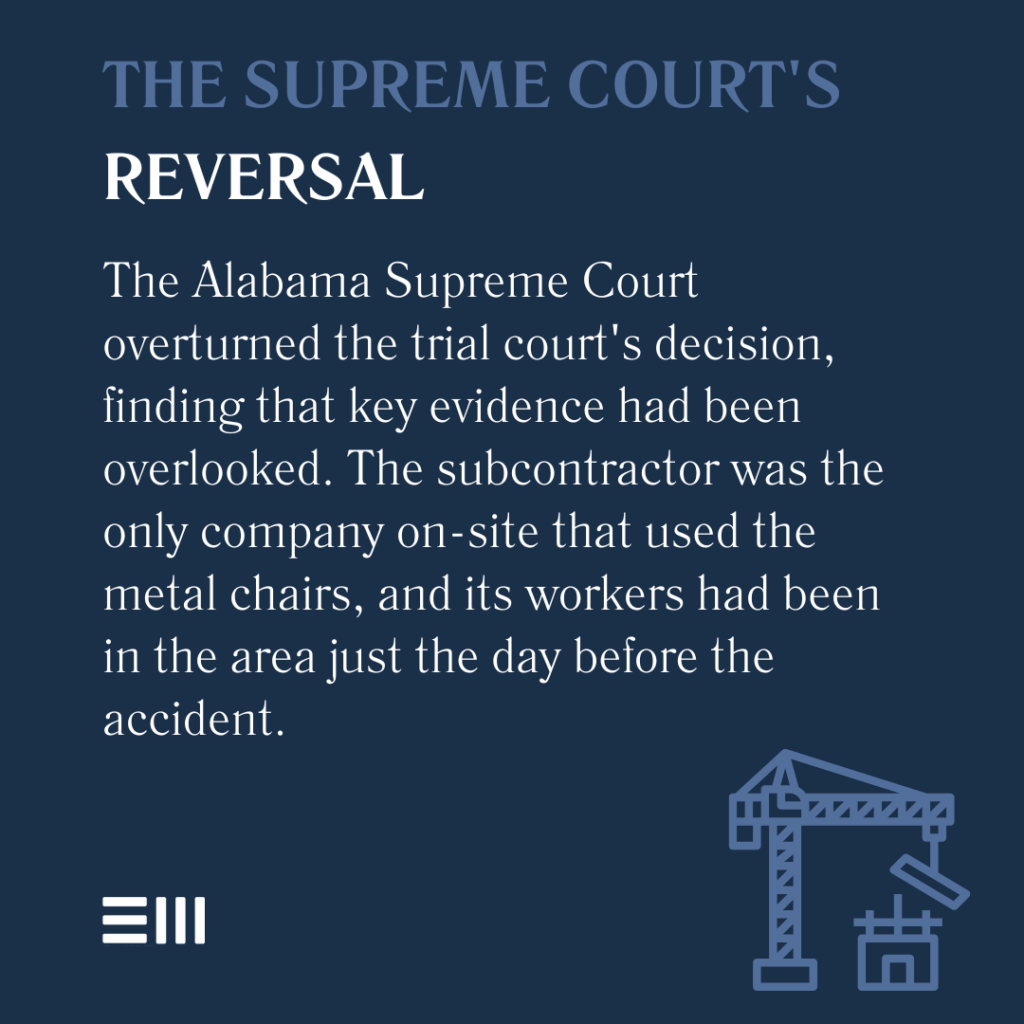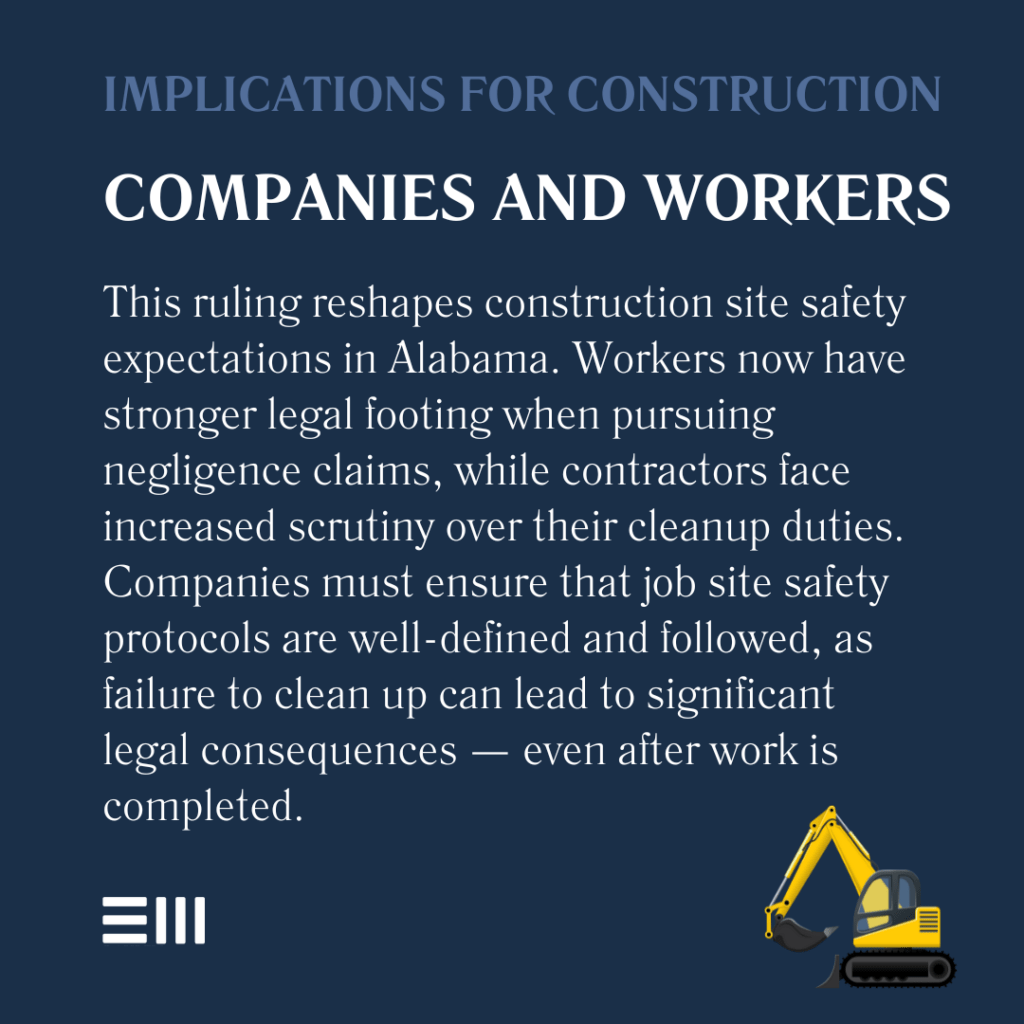
In a significant decision that could reshape how construction site injuries are litigated in Alabama, the state’s Supreme Court has overturned a directed verdict that dismissed a concrete finisher’s negligence claim against a subcontractor.
The November 8, 2024, ruling in Marina v. Bama Reinforcing, LLC reinforces the rights of injured workers and clarifies the standards for establishing liability in complex construction site cases.
The Case Background
The case centered on a worker who suffered a foot injury while working as a concrete finisher at the new FBI building construction site at Redstone Arsenal near Huntsville.
According to court documents, the worker stepped on a metal chair fragment—a component used to hold rebar in place during concrete pours—that penetrated his boot and injured his foot.
The injured worker filed a negligence action against the subcontractor responsible for rebar installation on the project. The subcontract explicitly required this company to clean its work areas and keep them free from rubbish and debris—a critical detail that would become central to the Supreme Court’s analysis.
The Trial Court’s Decision
During the trial, evidence established several important facts:
- The subcontractor was not present at the project on the day the injury occurred;
- The subcontractor was the only company on site that installed and handled concrete chairs; and
- A witness for the subcontractor testified that its employees did not cut chairs as part of their work.
At the close of evidence, the subcontractor sought a directed verdict dismissing the negligence action, arguing insufficient evidence to establish that they were responsible for cutting the chair and failing to clean the debris. The trial judge granted this motion, emphasizing three facts in an oral ruling:
- The subcontractor did not cut chairs;
- The subcontractor had completed its work on the concrete slab at least a day before the accident; and
- All contractors had a duty to clean up the job site.
This ruling effectively ended the case before it could reach a jury—a decision the Alabama Supreme Court would ultimately find problematic.
The Supreme Court’s Reversal
On November 8, 2024, the Alabama Supreme Court overturned the trial court’s ruling on the grounds that it failed to follow the appropriate standard of viewing the facts in the light most favorable to the plaintiff worker.
The Supreme Court specifically faulted the trial court for not addressing the testimony that the subcontractor was the only contractor on site who used the metal chairs. They also criticized the trial court’s flawed reasoning regarding the different contractors’ cleaning obligations.
In its analysis, the Supreme Court outlined what it called a “logical sequence” in the evidence:
- Only the subcontractor used chairs on the site;
- The subcontractor’s employees had worked in the same area the day before the accident; and
- The subcontractor had a clear duty to clean up that area upon completing its work.
The court concluded that “the evidence points to [the subcontractor’s] negligent cleanup being the reason the piece of chair was left on the ground in the work area for [the plaintiff] to step on.”

Legal Principles Established
The Supreme Court reaffirmed a crucial legal principle in negligence cases: “it is no defense, in actions for injuries resulting from negligence, that the negligence of third persons contributed to cause the injury to the plaintiff if the negligence of the defendant was an efficient cause, without which the injury would not have occurred.”
In simpler terms, even if other parties might share some blame, the subcontractor could still be held liable if their negligence was an essential link in the chain of events leading to the injury.
The court also emphasized that when the evidence indicates the subcontractor’s “negligent cleanup initially allowed the piece of chair to be present in the work area,” it is legally possible for them to be held liable for the alleged negligence.
Implications for Construction Companies and Workers
This ruling has several significant implications for stakeholders in Alabama’s construction industry:
For Construction Workers:
The decision strengthens the position of injured workers seeking compensation for on-site accidents. It affirms that workers don’t need to prove with absolute certainty which party caused dangerous conditions—only that the evidence logically points to a particular defendant’s negligence.
For Contractors and Subcontractors:
Companies must now be especially vigilant about their contractual cleanup obligations. The case demonstrates that a subcontractor can be held liable for injuries occurring even after they’ve left the site if they failed to properly clean up potentially dangerous materials specific to their work.
For Project Managers:
The ruling underscores the importance of clearly defined responsibilities for site safety and cleanliness. When multiple contractors share a workspace, explicit protocols for cleanup and inspection become even more critical.

The Challenge of Directed Verdicts
This case highlights the challenges courts face when trying to rule as a matter of law in situations requiring fact-intensive inquiry. The Supreme Court seemed concerned that the trial court was inappropriately inserting itself as the factfinder and misapplying or misinterpreting relevant facts.
Legal experts note that directed verdicts—which take decisions away from juries—should be granted sparingly in negligence cases, especially when reasonable minds could differ on the interpretation of evidence.
Looking Forward
The subcontractor will now likely face a retrial with all the associated costs and uncertainties. More broadly, this decision may prompt construction companies across Alabama to review their site safety protocols, cleanup procedures, and subcontractor agreements.
For injured workers, the ruling provides a clearer path to establishing liability in complex construction site accidents where direct evidence of negligence might be limited, but circumstantial evidence points to a logical chain of responsibility.
Need Legal Guidance? Contact Baxley Maniscalco
If you’ve been injured in a workplace accident, understanding the complex legal principles that might apply to your case is crucial. Construction site injuries often involve multiple contractors, complex contractual relationships, and challenging questions of liability.
Baxley Maniscalco’s experienced personal injury attorneys understand the nuances of construction site liability and have the expertise to build compelling cases based on both direct and circumstantial evidence.
Our team has helped numerous injured workers secure the compensation they deserve, even in complex cases involving multiple parties.
Contact Baxley Maniscalco today to schedule a consultation and learn how we can help you navigate the legal process after a workplace injury.
Can't find what you're looking for? Search our site below.










